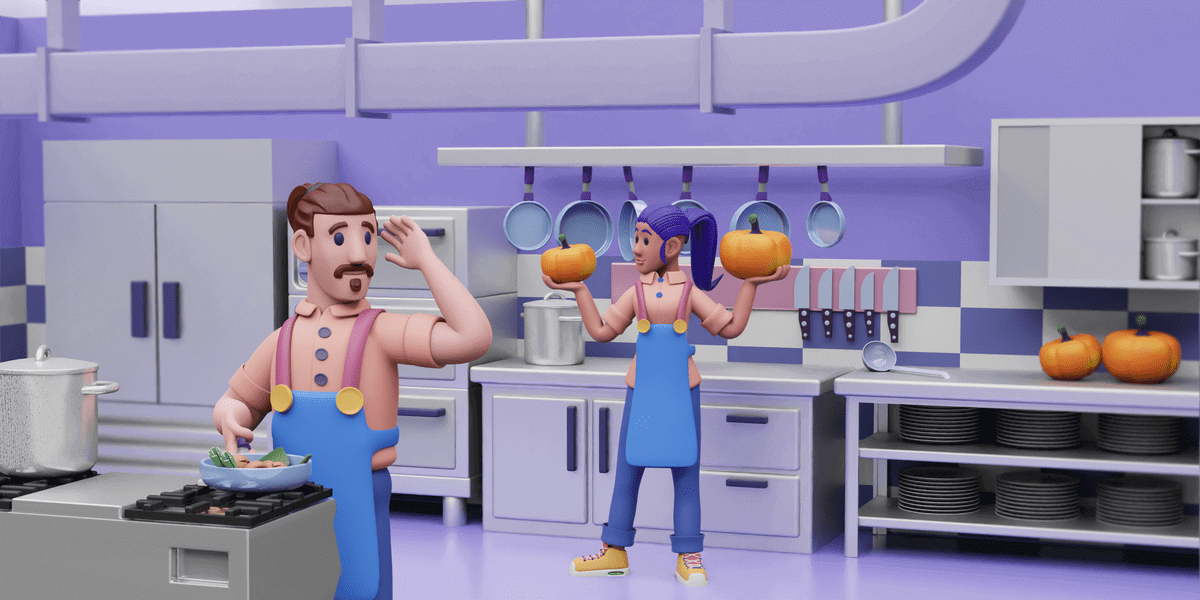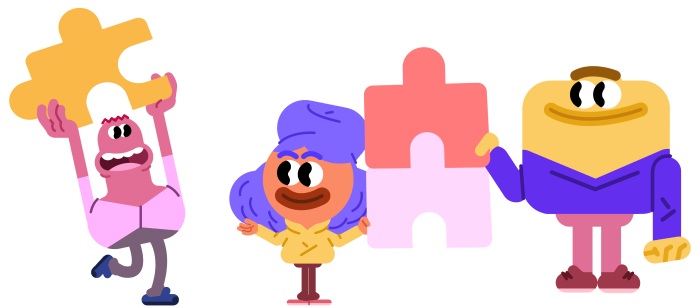O vocabulário corporativo é composto de palavras da moda e frases de efeito que nem sempre se correspondem ao seu verdadeiro significado. Isso não quer dizer que haja qualquer intenção negativa, mas que alguns termos são frequentemente usados de forma superficial, sem levar em conta as nuances de suas definições.
“Colaboração” e “trabalho em equipe” aparecem com destaque no vocabulário corporativo, e por um bom motivo. Afinal, colaboração e trabalho em equipe são realmente os pilares de um ambiente de trabalho saudável e produtivo.
Ainda assim, mesmo uma navegação casual por uma amostra aleatória de páginas de “valores/visão” em sites de negócios revelará uma grande quantidade de mal-entendidos e má aplicação em relação a esses termos. “Colaboração” e “trabalho em equipe” são frequentemente usados de forma intercambiável como sinônimos, embora haja diferenças significativas em seus significados.
Neste artigo, faremos o nosso melhor para esclarecer as distinções entre colaboração e trabalho em equipe, determinar onde elas se sobrepõem e onde divergem e por que essa distinção é tão importante.

As principais diferenças entre colaboração e trabalho em equipe
A principal diferença entre colaboração e trabalho em equipe é a diversidade de habilidades na colaboração, em contraste com a similaridade de competências no trabalho em equipe. Os membros do trabalho em equipe realizam tarefas individuais de forma independente, enquanto nas equipes colaborativas, eles se unem, aproveitando habilidades complementares para alcançar objetivos comuns.
Além disso, a criação do trabalho em equipe requer acordo, enquanto a colaboração em grupo promove a incerteza positiva ao criar algo novo em vez de seguir uma estrutura familiar.
Dê uma olhada na tabela abaixo para ver as outras principais diferenças entre trabalho em equipe e colaboração.
| Trabalho em equipe | Colaboração |
|---|---|
| Conjuntos de habilidades semelhantes entre os membros da equipe | Conjuntos de habilidades diversas para contribuição criativa |
| Autonomia individual dos membros da equipe | Autonomia fluida com tomada de decisão compartilhada |
| Definição e divisão claras de papéis | Funções flexíveis, adaptadas às necessidades do projeto |
| Liderança e hierarquia definidas | Liderança compartilhada e sem hierarquia rígida |
| Foco na proficiência e na conclusão de tarefas | Essencial para soluções criativas |
Vamos nos aprofundar nessas distinções para entender melhor as diferenças entre ótima colaboração e trabalho em equipe.
🎓 DICA PROFISSIONAL DO PUMBLE
Depois de entender as diferenças entre colaboração e trabalho em equipe, leia nosso artigo sobre como melhor utilizá-los para o sucesso:
O trabalho em equipe unifica papéis, enquanto a colaboração prospera na diversidade
Ao contrário da similaridade de papéis e conjuntos de habilidades comumente associados ao trabalho em equipe, a diversidade de habilidades, papéis e perspectivas é uma das qualidades definidoras da colaboração.
Em vez de todos os membros da equipe puxando na mesma direção, a colaboração reúne profissionais de diferentes especialidades para combinar suas habilidades e conhecimentos para atingir um objetivo comum que não poderia ser alcançado por meio da dependência de um único conjunto de habilidades.
Enquanto o trabalho em equipe eficaz depende da coordenação para atingir o pico de produtividade, a colaboração não prospera na adesão a um cenário predeterminado, mas sim na improvisação.

A colaboração atinge seu potencial máximo por meio de:
- Choque de perspectivas,
- Diálogo ativo entre colaboradores e
- Livre troca de ideias, percepções e opiniões.
Todos esses fatores reforçam a capacidade coletiva da equipe de resolver problemas e alimentar a inovação.
🎓 DICA PROFISSIONAL DO PUMBLE
A diversidade é uma virtude de qualquer ambiente de trabalho saudável que traz resultados impressionantes. Aprenda como você pode promover uma comunicação mais inclusiva no trabalho lendo nosso guia:
O trabalho em equipe promove o acordo, mas a colaboração estimula a inovação
O trabalho em equipe, assim como seus estágios evolutivos anteriores de cooperação e coordenação, estão enraizados no acordo — um entendimento compartilhado de papéis e responsabilidades individuais com resultados e saídas razoavelmente definidos.
Em contraste gritante, a colaboração está enraizada na incerteza positiva e na imprevisibilidade — o potencial de criar algo novo, em vez de executar dentro de uma estrutura familiar de expectativas.
O aspecto criativo enfatizado da colaboração é bem descrito por Michael Schrage em seu livro Shared Minds:
“A colaboração é o processo de criação compartilhada: dois ou mais indivíduos com habilidades complementares interagindo para criar um entendimento compartilhado que nenhum deles possuía anteriormente ou poderia ter alcançado sozinho.”
A colaboração, ao contrário do trabalho, em equipe, prospera na diferença e oferece as maiores recompensas ao desafiar perspectivas cristalizadas.
🎓 DICA PROFISSIONAL PUMBLE
A inovação é um dos maiores benefícios da colaboração — e para descobrir quais são os outros, visite nosso artigo:
O trabalho em equipe requer um líder, enquanto a colaboração floresce na flexibilidade
O trabalho em equipe, com sua abordagem estruturada, exige um líder, fornecendo uma cadeia de comando clara. Por outro lado, a colaboração prospera na flexibilidade, abraçando uma liderança compartilhada que se adapta às necessidades do coletivo.
O líder no trabalho em equipe desempenha um papel fundamental em:
- Fornecer orientação,
- Tomar decisões e
- Garantir que as tarefas sejam concluídas corretamente.
Em contraste, como mencionamos antes, a colaboração efetiva é o cenário perfeito para a criação inovadora que requer discussões e a livre troca de ideias. Sua abordagem compartilhada para a tomada de decisões promove uma dinâmica mais fluida.
Atendendo a propósitos diferentes, o trabalho em equipe foca na proficiência e na finalização de tarefas, enquanto a colaboração é essencial para soluções criativas. Ambas as estruturas contribuem para a eficácia geral de uma equipe ou projeto colaborativo.
🎓 DICA PROFISSIONAL DO PUMBLE
Ser um comunicador eficaz é uma das principais características de um bom líder. Promova o sucesso do trabalho em equipe aprendendo como transmitir melhor informações importantes aos membros da sua equipe:
O Pumble eleva a dinâmica da equipe
Tanto o trabalho em equipe quanto a colaboração desempenham um papel importante nas operações das organizações modernas. Na verdade, eles frequentemente se sobrepõem, ocorrem em paralelo, simultaneamente ou de forma intercambiável.
Independentemente do objetivo, ambos os conceitos são fomentados por uma comunicação eficaz e canais confiáveis.
À medida que exploramos as nuances entre colaboração e trabalho em equipe, é essencial reconhecer ferramentas que aprimoram as interações da equipe. O Pumble, um aplicativo de comunicação de equipe, fornece recursos para as necessidades estruturadas do trabalho em equipe e o espírito inovador da colaboração, tornando-o a plataforma ideal para a unidade e criatividade.
Como avaliamos esta publicação: Nossos escritores e editores monitoram as postagens e as atualizam quando novas informações ficam disponíveis, para mantê-las atualizadas e relevantes.
